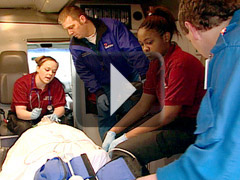A New Way of Learning: Innovative School Models
Progressive secondary school programs focus on personalized education, development of self-esteem, and cultivation of learning and life skills.
Your content has been saved!
Go to My Saved Content.
Running Time: 6 min.
What are some of the newest strategies for reinvigorating high school education? Not surprisingly, they're slightly different in every community. But several core goals stand out:
Personalized Learning
Many education experts believe learning works best when it is personalized. For Dennis Littky and Elliot Washor, founders of the Metropolitan Regional Career and Technical Center (the Met), in Providence, Rhode Island, personalized learning means designing a blend of courses, internships, and experiences that respond to the needs and interests of every student. At Met West High School, in Oakland, California, one of several schools throughout the country based on the Met model, standardized curricula takes a backseat to personalized instruction. Here, some students take courses at a nearby community college; others receive tutoring to improve basic writing and math skills. And all participate in internships through which they can follow their passions, from helping prepare a lawsuit to rebuilding a race car to launching a stress-reduction center for college students.
At San Francisco's Gateway High School, personalized learning means helping students understand their own learning styles and developing teaching and learning strategies that fit individual abilities. The school maintains learning profiles that provide detailed information about each student's strengths and weaknesses, which teachers use to personalize learning.
For the community at the Frances W. Parker Charter Essential School, a school in Devens, Massachusetts, for students in grades 7-12, it means having parents, students, and teachers meet each fall to identify specific goals for each attendee, a list that forms the basis of a personalized learning plan.
College -- and Life -- Prep
Many communities are transforming their large high schools into smaller learning centers that better prepare students for college or full-time employment. Enter the career academy.
At South Grand Prairie High School, in Grand Prairie, Texas, for instance, educators have divided their 2,500-student high school into five career academies. There, students are offered a range of academic and professional options, from working on an ambulance crew under the auspices of the Health Sciences and Human Services Academy to becoming a student teacher in one of the Communications, Humanities, and Law Academy's component programs. The primary goal: Connect classroom learning to real-life applications. Students earn valuable job skills, understand academics in the context of their jobs outside the classroom, and leave high school with scholastic and work records that give them many academic and employment options.
Says Principal Roy Garcia, "We wanted to give each and every student the opportunity to explore and experiment to find out what they want to do."
Building Skills and Confidence
For many high school students, attending college is not academically, economically, or practically feasible. They don't have the skills, the confidence, or the motivation to stay in high school, let alone continue on to a two- or four-year college.
A new breed of secondary schools, dubbed early-college high schools, attempt to reverse the cycle that dooms low-achieving, and often low-income, kids to drop out or graduate unprepared for adult life. These new small schools are formed by a diverse group of partners, including the City University of New York, which will open ten early college high schools throughout New York City, and the National Council of La Raza, which is creating twelve schools to serve Latino communities. Located on community-college campuses, the schools provide students with the academic support they need to not only finish high school but also graduate (sometimes in six years, rather than four) with both a high school diploma and a postsecondary degree.
The power of this model isn't just in the structure; advanced high school students have taken college courses for years. The real value, says Hilary Pennington, vice chair and cofounder of Jobs for the Future, is for the students that early college high schools target: young people who start with a variety of disadvantages and are typically underrepresented in higher education.
Roberta Furger is a contributing writer for Edutopia.
Learn More
Would you like to learn more about the new face of high school? For an up-close look at innovative high schools throughout the country, together with information about the organizations leading the way in high school reform, go to this directory of Edutopia.org content about high schools. You'll find feature articles, videos, and multimedia stories, as well as links to useful resources and organizations.